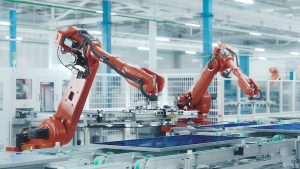How variable speed drives impact energy costs – what you need to know
The manufacturing industry is a major consumer of energy. Based on the International Energy Agency (IEA) 2021 analysis of world energy statistics (which reflects 2019 data), Industry is globally responsible for nearly 42% of electricity energy usage and 37% of natural gas consumption. Therefore, energy prices have a key impact on the competitiveness and profitability of manufacturing firms. This particularly affects those organizations whose plants house many electrical motors and few variable speed drives (VSDs) to control them.
We at Quantum Controls, a UK-based Schneider Electric Alliance Partner and systems integrator, have watched as energy prices in the UK have increased by up to 400% over the last six months. Even though the UK government recently announced a cap on energy costs at 0.25 p/kWh, this is still a significant increase in costs compared to the 0.07 p/kWh previously paid by the manufacturing sector. This has triggered renewed efforts among many manufacturing firms to find new ways to generate energy savings and efficiency.
Across the UK, industry experts estimate that over 10 million industrial motors are in production. Let’s look at the example of typical water and wastewater operation systems. Electric motors represent 85% of all the operational electricity consumption (the motors are used to drive expansive networks of pumps and related equipment). Many of these motors consume much more energy than is needed to perform standard functions. Depending upon the motor application, installing modern VSDs can drastically reduce energy consumption (in some cases by up to 50%). This, in turn, can significantly impact plant energy bills.
Do variable speed drives (VSDs) increase energy efficiency for all motor systems?
Unfortunately, some manufacturing customers are being misled by equipment vendors’ claims regarding the benefits of VSDs. The drastic reductions in energy consumption cannot be realized for all applications related to motors. For instance, in the case of constant torque applications (like the motors that run conveyor belt plant processes), efficiency gains will likely not surpass 10%.
On the other hand, if VSDs are connected to motors that run centrifugal operations (like running a fan or a pump), energy consumption reductions of up to 50% are realistically possible.
In these cases, attaching VSDs to 160kW motors with an annual operating cost of £175,000 UK pounds (approximately $200,000 US dollars) – and there may be hundreds of these in one facility – can result in hundreds of thousands of pounds or more in energy savings. Such gains also continue to accrue throughout the lifetime of the VSD asset.
Low-risk strategy for deploying variable speed drives (VSDs)
Examining the facts relevant to each VSD application is an excellent way to sort out the information and find the best solution in terms of energy savings. At Quantum Controls, we have developed a straightforward approach for determining the realistic VSD-related energy savings customers can expect before they commit to a long-term investment. Quantum engineers recommend a data-driven approach consisting of the following steps:
- Monitoring of an on-site motor for energy consumption – Quantum engineers install an energy monitor on a targeted motor to accurately determine how much energy that particular motor consumes over two weeks.
- Monitoring of motor with attached, rented VSD – Next, with a large stock of Schneider Electric VSDs available to them, our engineers fit a VSD to the client’s motor and then, again, measure that motor’s energy consumption over two weeks. During that time, the VSD is rented from Quantum Controls.
- Publication of an extensive energy consumption report – Once the performance data is gathered during steps 1 and 2, we report precisely how much energy was consumed and how much money was saved using the VSD. For clients who engage in such a process, the rental cost is typically very low compared to the amount of accrued savings.
- Auditing of the plant site to identify low-hanging fruit – Our engineers also audit the client plant site and identify the specific areas within the plant where the most energy can be saved by deploying VSDs.
- Structuring of a maintenance and support plan – Once VSDs are installed, many of our clients ask us to provide technical support and maintenance. As a Schneider Electric service partner, we can offer 24×7 support to our clients. Through on-site visits, we tune the equipment when needed and maintain the highest efficiency performance of the drives and motors.
For more information
At Quantum Controls, we deploy high-quality Schneider Electric Altivar APM drives. These are among the highest efficiency drives on the market. Our customers decide to invest in these drives not only because of the significant energy savings. The VSDs provide motor and drive information such as motor current, motor thermal state, motor torque, drive thermal state, and other critical data. This allows for either on-site or remote in-depth diagnostics and root cause analysis, should an issue arise.
Thanks to these intelligent drives, harmonics (electrical disturbances) can be kept to a minimum, and issues can be addressed before any unanticipated downtime occurs.
Visit the Quantum Controls and Schneider Electric websites to learn more about VSDs and how they relate to energy savings.



